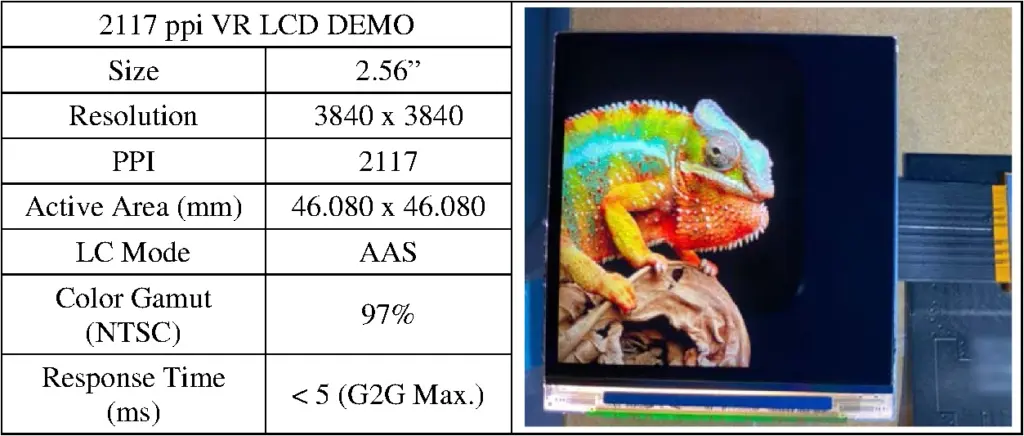Virtual reality (VR) displays are advancing at a rapid pace, with resolution and pixel density rising exponentially in recent years. While current consumer VR headsets max out around 1200 pixels per inch (PPI), researchers at Innolux have achieved a paradigm shift, developing an ultra-high resolution 4K VR liquid crystal display (LCD) exceeding 2000 PPI. This paper follows on from work that was highlighted last month, by most of the team members on this research, which looked at LCD-based light field displays.
In this new research paper published in the Journal of Optical Microsystems, Dr. Yung-Hsun Wu and colleagues detail their innovative display which attains 2117 PPI, far surpassing anything commercially available. The researchers claim this enables a visual experience free of the screen door effect with crisp detail that significantly enhances VR immersion.

So how did they accomplish this engineering feat? Fabricating a display with such minuscule pixels pushes production equipment past its limits. To work around these lithography constraints, the team implemented clever subpixel rendering techniques that optimized pixel size and spacing. This hybrid design permitted the manufacturing of finely patterned components beyond the 1 μm resolution barrier.
But pixel density alone doesn’t guarantee performance. The team tackled aperture ratio issues stemming from bulky thin-film transistors (TFTs) occupying substantial real estate within each pixel. By shrinking TFT dimensions through meticulous design and process refinements, aperture ratios doubled to around 19% — a major gain in transmittance and brightness.
Further clever optimizations of the indium tin oxide (ITO) electrodes coaxed greater liquid crystal efficiency within the tight confines of the tiny pixels, enhancing light throughput by an impressive 70%. The researchers also eliminated color shift at wide viewing angles through optical shielding layers.

A key concern as resolution scales is the accompanying exponential rise in power consumption. To combat this, the team implemented dual-voltage driving to match supply levels to functional needs, saving significant energy. Other tactics like lowering driving frequencies, innovative circuit architectures, and parasitic capacitance reduction also curtailed power demand.
With boosted resolution, achieving the high dynamic range and contrast of rival OLED displays remained an issue. Here the integration of a MiniLED backlight proved pivotal. Its high color purity, narrow emission spectra, and quantum dot color conversion expanded color gamuts to fully cover the DCI-P3 standard. Local dimming with 1024 zones sharpened light/dark transitions for better image pop. Further backlight innovations yielded an incredibly slim 0.9 mm unit ideal for comfortable VR wearables.
The end result of these cross-disciplinary display advances is a 2.56” 4K x 4K LCD with industry-leading 2117 PPI density. Dr. Wu calls their achievement an “industry first,” noting that it provides exceptional visual detail and immersion for VR users. But what does this mean for the display industry and VR market? LCD technology has faced intensifying competition from MicroLEDs and MicroOLEDs in recent years, especially at the high end. The Innolux prototype demonstrates that LCD remains a highly viable option capable of matching and even exceeding its rivals’ capabilities through creative engineering. It offers a more mainstream-friendly solution compared to the astronomical pricing of novel technologies.

Nonetheless, Dr. Wu acknowledges microdisplays still hold advantages in compact form factors desired for ultra-sleek designs. He views each technology as serving distinct segments of the VR landscape. There remains ample room for further LCD innovation to push boundaries of resolution, dynamic range, and pixel response speeds.
If consumer appetite for more immersive and visually rich VR experiences grow, displays will need to evolve apace. Innolux’s 2000+ PPI LCD represents a tentative step into the display realm of the future. It expands notions of what’s currently achievable and brings us closer to the day when VR environments match and surpass reality. Yet it is just one milestone on the long road still ahead.
Reference
Yung-Hsun Wu, Chia-Hao Tsai, Yi-Hsiu Wu, Yi-Shiuan Cherng, Ming-Jou Tai, Potilar Huang, I-An Yao, and Chiu-Lien Yang “Breaking the limits of virtual reality display resolution: the advancements of a 2117-pixels per inch 4K virtual reality liquid crystal display,” Journal of Optical Microsystems 3(4), 041208 (11 October 2023). https://doi.org/10.1117/1.JOM.3.4.041208

